Loughborough Grammar School Nepal Expedition: 30 Years on
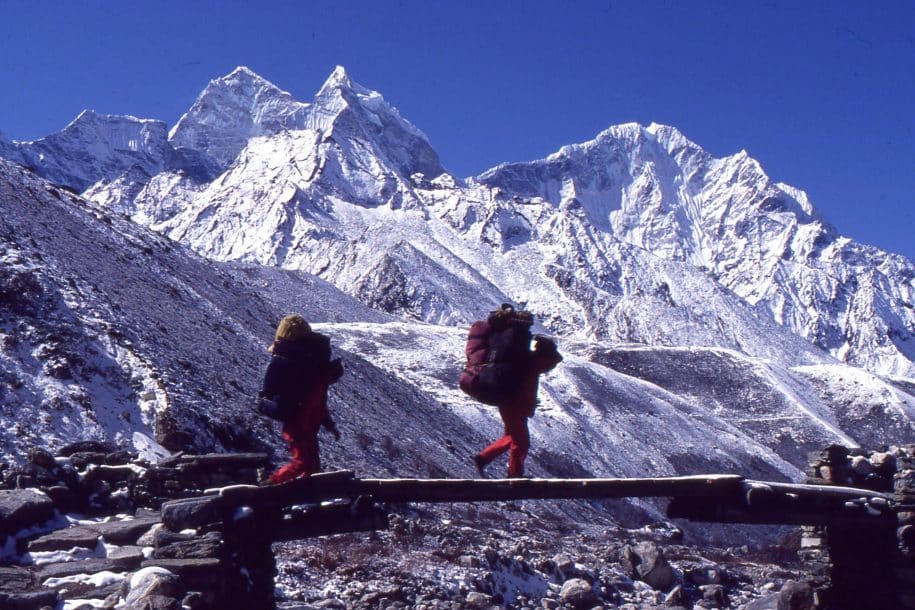
30 years ago, on 28 March 1993, 16 boys and 5 members of staff set off on a once-in-a-lifetime expedition to Nepal to trek in the Everest region. The main aims of their expedition were:
- To climb three trekking peaks of over 5000 metres (Gokyo Ri, Kala Patar and Pokalde)
- To see Mount Everest and visit Everest Base Camp
- To experience the culture and way of life of a less developed country
- To help the work of Sir Edmund Hillary’s Himalayan Trust by carrying medical and educational supplies to a Sherpa school and Hospital.
This school trip began earlier than most, with two training camps to prepare the team for the challenging trek ahead in Nepal. The first of these training camps took place in October 1992, in the Lake District where the team climbed Scafell Pike in a Blizzard! The second camp saw the trekkers take on Snowdonia during Spring half-term 1993.
Photograph below: The expedition team stood on the Cantilever Stone on Glyder Fach. This was on one of our training camps.
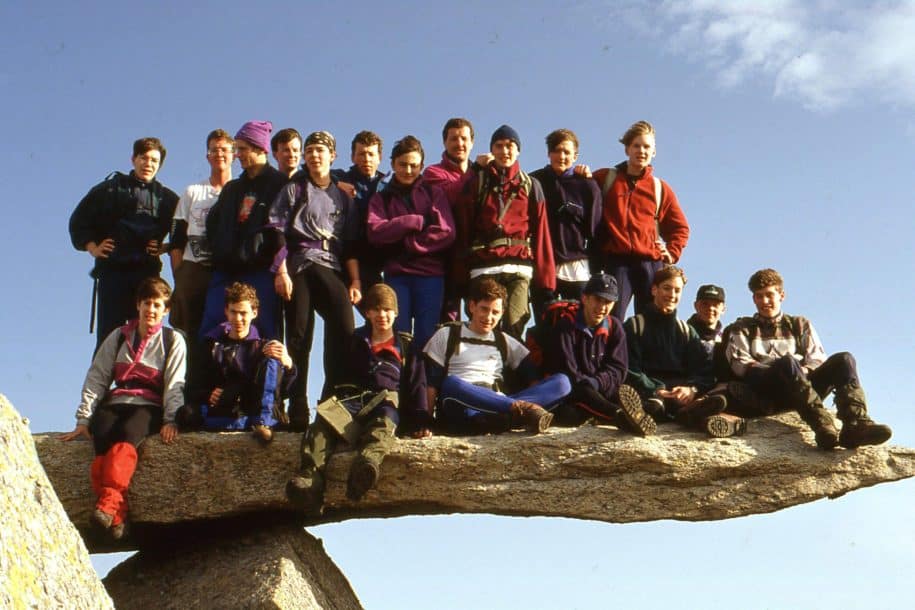
Alongside training, the team wrote letter after letter trying to gather sponsorships for the educational and medical equipment to take with them for the Sherpa school and hospital. Alongside their personal kit, the team carried an extra 114kg of supplies between them including:
- A bench top sterilizer unit (autoclave) from LTE Scientific
- An autoclave from Eschmann Bros. and Walsh
- A micro-centrifuge from Sanyo Gallenkamp
- Portable baby weighing scales
- A class set of atlases from Fairfield School
- Posters and books from Ladybird and WH Smith
- Stationery from the Midland Bank
- Books and crayons from LGS pupils.
30 years on, former LGS staff and member of the expedition team, Jim Crookes reflects on this incredibly challenging yet fascinating and rewarding journey.
Reflections by Jim Crookes
It was on 28 March 1993, exactly 30 years ago as I write, that 5 members of staff and 16 boys from LGS gathered with feelings of excitement and trepidation for their pre-departure photograph at the Quad Gates. This moment followed months of detailed planning and preparation with training camps in the Lake District and Snowdonia, and a big fund-raising effort for medical and educational supplies for hospitals and schools set up by the Himalayan Trust, founded in support of the Sherpa people by Sir Edmund Hillary. It was almost 40 years earlier that Sir Edmund Hillary and Sherpa Tenzing Norgay conquered Everest, and to mark that special occasion there was to be a reunion of the surviving members of the 1953 expedition which coincided with our time in Nepal. The next 24 days were to provide significant physical and mental challenges for us all, but there is no doubt that they also contained some of the most unique and special moments that any trekking enthusiast could wish for.
The aim of our expedition was to trek to Everest basecamp and explore the Gokyo and Khumbu valleys, crossing a high pass connecting the two called the Cho La. We hoped to climb two well-known trekking peaks called Gokyo Ri (5320m) and Kala Patthar (5645m) which would afford spectacular views of Everest, weather permitting. We also planned to deliver educational and medical supplies to Khumjung School and Khunde Hospital which lay close to Namche Bazaar which is famous for its ancient Sherpa culture, traditions and warm hospitality. Those wishing to read detailed accounts of this trip can find an excellent article written by Michael Cunnington in the 1993 edition of the Loughburian (see www.lgs-heritage.org) and the official Nepal 1993 Expedition Report which was beautifully compiled by Henry Mount.
So, 30 years on, what are my key memories of those amazing 24 days in Nepal?
Firstly, there is no doubt that this expedition was made absolutely unique by our privileged meeting with Sir Edmund Hillary shortly after our scary landing at Lukla airstrip which marks the start of the challenging trek to Everest Basecamp. Here, we were able to formally present £4000 worth of educational and medical supplies to Sir Edmund and the Himalayan Trust; these had been donated by many generous individuals and companies in our local community. Sir Edmund was also accompanied by Lord Hunt, George Band, George Lowe, Mike Westmacott and Charles Wylie, all of whom we were to later encounter in a restaurant in Kathmandu at the end of our trip. The huge number of silk scarves draped around Sir Edmund’s shoulders was an indication of the esteem in which he was held by the local Sherpa people. Many other famous climbers had also gathered to witness this special occasion, including Chris Bonington whom we later met on our way to Namche Bazaar along with a famous Sherpa called Pertemba who had successfully climbed Everest by three different routes.
Photographs below:
Left: Presenting medical and educational supplies to Sir Edmund Hillary at Lukla.
Right: Meeting the staff at Khunde Hospital.
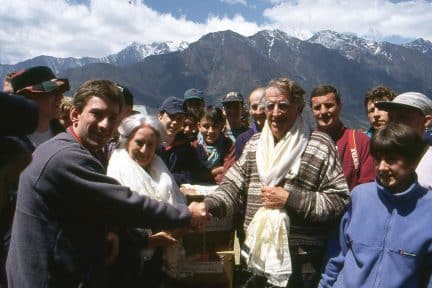
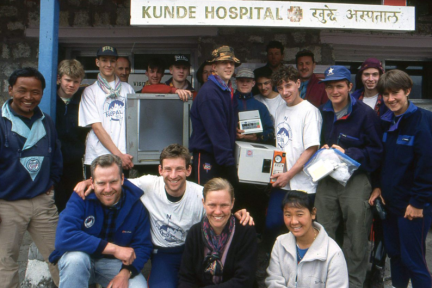
Secondly, inevitably we were to be in awe of the stunning Himalayan scenery with the majestic peak of Ama Dablam dominating our view for much of the way. However, we all prayed for a good view of Everest and its 8000m neighbours from our ascents of Gokyo Ri and Kala Patthar. For me, the ascent of Gokyo Ri was particularly memorable. After a reluctant decision to split the group for health reasons (see below), the group I was with arrived in the tiny settlement of Gokyo just after midday after a dawn start. The adjacent lakes were frozen and deep fresh snow covered our potential camp spot (this also prevented our crossing of the Cho La). However, much to our relief we were spared the task of clearing the snow for our tents when space was found in a small lodge, so we settled in there with a warm fire glowing. Being a restless soul I asked if anyone would be interested in taking a walk up the side of Gokyo Ri to a point where we might see the summit of Everest if it was clear. I had two volunteers, Ian Hecks and James Edley. The weather pattern for the last few days had seen a cloudy start with the skies clearing by late afternoon, so we set off with our fingers crossed! Slowly but steadily with our hearts pounding due to the thin air, we inched our way up the mountain. The skies cleared and at last Everest came into view. Spurred on by the incredible view we couldn’t resist the temptation to reach the top which we did as the sun was setting on the south-west face of Everest and the temperature plummeted causing my fingers to stick to my metal camera tripod. But what a moment! We spent little time on the top as the light was fading fast and we arrived back in Gokyo after dark, just in time for the evening meal which was about to be served. What timing! The following morning we returned to the summit once again with the rest of the group but the early morning mist deprived us of the spectacular view we had hoped for. However, were all blessed at last with a view of Everest and its surrounding peaks a few days later from the summit of Kala Patthar, just before the weather turned for the worse and forced our departure from the upper reaches of the Khumbu Valley.
Photographs below:
Left: Mt Everest.
Right: Michael Cunninton on top of Kala Patthar with Mt Everest behind.
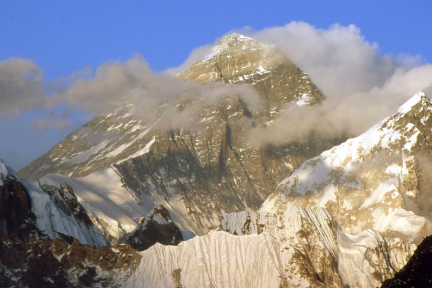
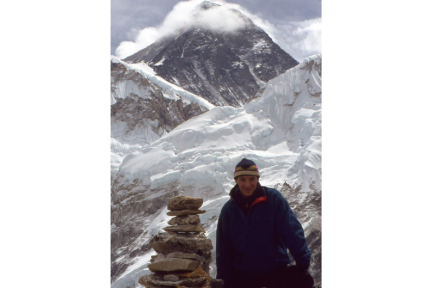
Thirdly, the whole experience was undoubtedly enriched by the team spirit and the resilience of the expedition members. After two training camps, regular fitness sessions and many planning meetings we had come to know each other well, but the real test came when the inevitable effects of altitude and tummy upsets began to take their toll. Our ascent towards Everest basecamp was deliberately slow and everyone took Acetazolomide as a prevention, but there is still no way of knowing who may succumb to altitude sickness. Fortunately, we had no severe cases, but chesty coughs and diarrhoea significantly affected about half of the group. A decision was made to split the group to enable some to head to Gokyo while the others could make a steadier ascent to Pangboche, the highest permanent settlement in the Khumbu valley, from where we would all, hopefully, make an ascent of Kala Patthar. Life under canvas with sub-zero (-15C on some) night-time temperatures, pre-dawn starts, long days of trekking at altitude, pungent pit toilets and no washing facilities apart from a tepid bowl of water or an icy stream, provided a real test of character. But the warmth and banter in the mess tent every evening as we digested our rice with yak stew followed by rice pudding always raised our spirits and kept us going!
Photographs below:
Left: Evening meal time in the mess tent.
Right: Group photo at the summit of Kala Patthar
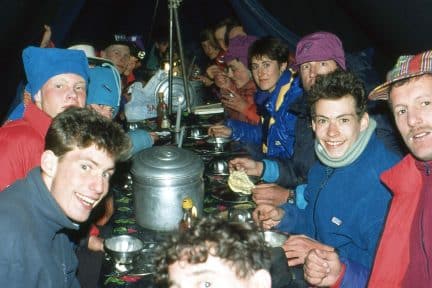
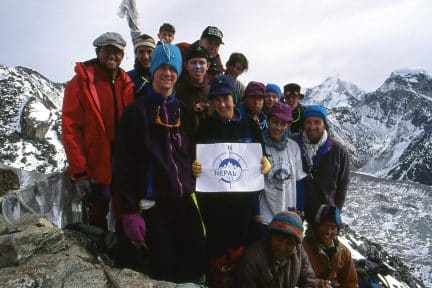
Fourthly, the amazing Sherpa people. Every large expedition like ours absolutely depends on a large team of porters, yaks, cooks, guides and a head Sherpa or Sirdar. Our team ran to 65 porters, 6 yaks, 2 cooks and 10 assistants, 6 sherpas and our Sirdar, Maila Pemba Sherpa. All set about their hard work with good cheer and a commitment to ensuring that our expedition would be a success, just as they would if they were heading to the summit of Everest. I will never forget seeing a porter with another porter lying unconscious on a special frame on his back running down the valley below Pangboche. He had been working high up on Everest and succumbed to altitude sickness. Sadly, we were to later learn that he died further down the valley, a sober reminder of the dangerous work undertaken by Sherpas when working for high altitude expeditions. The warmth and genuine hospitality of the Sherpa people was always apparent whether it be in the lodges or shops of Namche Bazaar, or the post expedition party which we shared with our sherpa team on our final night in Lukla. Yet the hardship of their existence in these high Himalayan valleys was always evident, and it was good to know that we had done something to help them through our fundraising for the Himalayan Trust.
Photograph below: Sherpa porters carrying supplies in the Khumbu Valley.

Fifthly, our homecoming. After a couple of days exploring the busy streets and beautiful temples of Kathmandu we set off for our return journey to London via Karachi, Islamabad and Dubai. Having spent the full three weeks of our Easter holiday away, we were expected to be in school the following morning. Not everyone made it on account of ongoing tummy upsets and considerable post-expedition fatigue, but some did! However, we could all feel extremely proud of what we had achieved over the past 24 days, and very privileged to have met the surviving Everest 1953 team members and seen that majestic mountain first-hand. Exactly two weeks after we landed, my beautiful daughter Lucy was born – thank goodness she waited for me and thank you to my wonderful wife Sue for her patience and understanding!
Photographs below:
Left: Camping under sub-zero temperatures and starry skies.
Right: James Edley and Ian Hecks on top of Gokyo Ri.

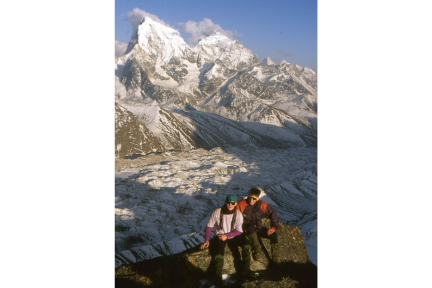
Finally, I would like to thank all of the pupils and their parents, the porters and staff leaders, and especially our generous sponsors, for all they did to make this amazing expedition such a success.
